Cracking the New SAT with 4 Practice Tests, 2016 Edition (2015)
Part VII. Practice Tests
Chapter 25. Practice Test 3: Answers and Explanations
PRACTICE TEST 3 ANSWER KEY
Section 1: Reading
1.A
2.D
3.D
4.D
5.C
6.C
7.D
8.B
9.A
10.A
11.D
12.B
13.B
14.C
15.B
16.A
17.A
18.C
19.C
20.D
21.A
22.C
23.B
24.D
25.C
26.B
27.B
28.A
29.C
30.C
31.D
32.D
33.C
34.B
35.B
36.B
37.C
38.C
39.A
40.D
41.A
42.C
43.B
44.B
45.B
46.D
47.B
48.C
49.D
50.C
51.C
52.B
Section 2: Writing & Language
1.B
2.C
3.B
4.D
5.D
6.C
7.A
8.A
9.C
10.B
11.D
12.C
13.B
14.D
15.D
16.A
17.B
18.D
19.A
20.C
21.C
22.B
23.B
24.D
25.D
26.A
27.C
28.D
29.C
30.C
31.A
32.B
33.A
34.C
35.B
36.A
37.D
38.A
39.C
40.B
41.B
42.D
43.D
44.A
Section 3: Math (No Calculator)
1.B
2.C
3.C
4.D
5.A
6.B
7.A
8.C
9.B
10.C
11.D
12.A
13.B
14.C
15.C
16.![]() or 2.33
or 2.33
17.6
18.6
19.8
20. or 26.6 or 26.7
or 26.6 or 26.7
Section 4 : Math (No Calculator)
1.D
2.A
3.B
4.B
5.C
6.B
7.A
8.C
9.B
10.D
11.B
12.C
13.D
14.C
15.B
16.A
17.A
18.D
19.C
20.D
21.C
22.C
23.D
24.A
25.A
26.B
27.D
28.A
29.C
30.D
31.75
32.5
33.918
34.19
35.6
36.20
37.1
38.8
PRACTICE TEST 3 EXPLANATIONS
Section 1: Reading
1. AThe main idea of the passage is that the Scarlet Pimpernel rescues French nobles because it is fun. Choice (A) is correct because that is the reason behind the Pimpernel’s actions. The characters never discuss the cause of the French Revolution, so (B) cannot be the answer. Because the young man is a member of the Scarlet Pimpernel’s team and both are self-confident, (C) is incorrect. Both characters presumably disagree with the French government, and neither ever questions that the government is ruthless. Therefore, (D) is incorrect.
2. DBecause there is no indication that the cart is moving quickly, (A) is wrong. Since the Comtesse is herself escaping arrest, (B) is incorrect; the mob would not be punished for catching a fugitive. Choice (C) is wrong, as we do not know that the woman driving the cart is violent, only frightening. In the sixteenth paragraph, the driver causes the mob to retreat by mentioning the plague. Therefore, (D) is correct.
3. DThe answer to the previous question is that the crowd did not approach the Comtesse’s cart because they were afraid of contracting a disease. Choices (A), (B), and (C) make no mention of any disease. Choice (D) is correct because it is the only answer that mentions disease or plague.
4. DIn the sentence in question, the flower is drawn in red. Therefore, designated must mean something like drawn. Choices (A), (B), and (C) all mean things other than drawn. Only illustrated means drawn. Therefore, (D) is correct.
5. CIn the passage, Lord Antony is explaining that the Scarlet Pimpernel and his companions save French aristocrats because it is exciting, like pulling the hare from between the teeth of the hound. Choice (A) is too literal; it is incorrect because Lord Antony is speaking metaphorically. In the passage, there is no mention of dead Englishmen. Therefore, (B) must be eliminated. Choice (C) is an accurate characterization of Lord Antony’s use of the phrase in question: In Lord Antony’s metaphor, the French aristocracy is the hare, and the harm is the teeth of the hound. Because the passage concerns the cruelty of French revolutionaries toward nobles, (D) contradicts the passage and is incorrect.
6. CThe answer to the previous question is that Lord Antony uses the phrase in question to describe the sensation of delivering French nobles from harm. Because (A) makes no mention of either the aristocrats or the danger they are in, it is incorrect. Choice (B) is incorrect because it describes the danger to the Pimpernel and his companions, not the French nobles. Choice (C) is correct because it describes the Pimpernel’s men delivering French nobles from harm. Because (D) describes only the danger that the Comtesse has found herself in, it should be eliminated.
7. DIn the sentence in question, the Comtesse is described as incredulous, which means that she has trouble believing the reason given to explain why the Pimpernel and his companions have gone to France to rescue aristocrats. She is not critical; therefore, (A) is incorrect. Nor is she anxious, meaning that (B) must be eliminated. While the Comtesse may be relieved that she has been rescued, the sentence in question describes her as incredulous. Therefore, (C) is wrong. Perplexed means puzzled; because the Comtesse finds the given explanation inadequate to explain the behavior, she is puzzled. Choice (D) is correct.
8. BBearded describes the Pimpernel’s men, who we know are courageous for rescuing the Comtesse. Therefore, bearded must mean something like “faced with courage.” Of the four answer choices, only (B) captures their courage in doing what they did. Therefore, it is correct.
9. AThe two sentences in question draw a contrast between the peace of England and the chaos of France. Tranquility means “peace” and turmoil means “chaos.” Therefore, (A) is correct. Choice (B) is incorrect because, while the inn is old-fashioned, there is no indication that France should be thought of as modern. While the Comtesse is free, that fact is not mentioned in the description of the inn or England, nor does she actually ever describe the mob as ignorant. (In fact, fleeing the plague seems a very intelligent thing to do.) Therefore, (C) is incorrect. Because austerity means “extreme simplicity,” (D) does not accurately describe the contrast between England and France.
10. AIn the paragraph in question, the Comtesse compares her perception of Sir Antony’s motives with those of Sir Andrew. Therefore, (A) is a good description of the distinction emphasized by the italics. There is never any indication that Sir Antony’s methods are different from Sir Andrew’s, so (B) is incorrect. While the Comtesse feels there is a distinction between Sir Andrew’s motivations and those of Sir Antony, (C) is incorrect: Antony is motivated by excitement, not money. And while the Comtesse sees a distinction between Antony’s motivations (a love of adventure) and Sir Andrew’s motive (one that is higher and nobler), (D) is incorrect because there is no mention that Andrew is seeking admiration and praise (which seems unlikely to be the higher motive she implies).
11. DThe passage is primarily concerned with descriptions of Roman baths, how they came into being, and what their significance is. Use POE to find an answer consistent. Choice (A) is incorrect because very little is discussed in the passage regarding sanitation. Choice (B) is too limited in scope, and (C) is incorrect because religion is never discussed in the passage. Choice (D) is a good match to the overall structure of the passage.
12. BThe first sentence is drawing a contrast between Greek and Roman architecture, so use POE to find an answer choice that shows this. Eliminate (A) because the passage doesn’t suggest that the Roman architecture improved on the Greek architecture. Choice (B) works because new trends shows how Roman architecture differed from Greek architecture. Choice (C) is too extreme since nothing is proven, so eliminate it. Choice (D) is also incorrect because religion is not discussed much in the passage.
13. BCross out omnipresent and use the context to find an acceptable replacement. The curves are also described as dominating, and later in the paragraph the world the architects created is described as one that was transformed into a new curvesomeness. This suggests that the curves are a characterizing feature, so find the choice that matches these descriptions. Choice (B) is the best match, since it means “everywhere.” Choice (A) is too limited, whereas (C) is a trap since it is the ceilings and not explicitly the curves that reached up to the heavens. Choice (D) is incorrect since it means “impressive in appearance.” Choice (B) is the best answer.
14. CThe second paragraph specifically states that this grand Roman innovation in architecture would be accomplished in two centuries as the essential ingredient, concrete, was perfected gradually by trial and error. Choice (C) is the best match for this information. The other answer choices do pertain to the passage, but since the question is asking for the critical component, (C) is the best answer.
15. BLines 16–19 identify concrete as the essential ingredient in Roman innovation and that it was perfected gradually by trial and error. Choice (B) is thus correct.
16. AThe third paragraph states that the new architectural creations arose from the needs of these Roman cities, so the correct answer will include something about these new needs driving the innovations. Choice (A) is a good match since the needs of the new Roman cities are what prompted the differences between Greek and Roman architecture discussed in the first paragraph. Choice (B) doesn’t work because the passage isn’t reinforcing this contrast as explaining why it happened. Choice (C) is alluded to at the end of the paragraph, but is hardly the primary purpose. The author is not dismissing anything, so get rid of (D). Choice (A) is the best answer.
17. AThe first sentence of this paragraph describes the grand Stabian baths and how some of their features would show up in the Pantheon three centuries later. Therefore, replace anticipated with something that means “indicated” or “suggested.” Choice (A) is the best match.
18. CUse POE to find an answer consistent with what the author states in the last paragraph. The paragraph details the variously heated and cooled spaces within the baths, which supports (C), since the baths were so critical a part of Roman life and offered the opportunity to experience different temperatures. Eliminate (A), since there is no comparison made in the paragraph to modern baths, and (B), since gyms are not mentioned. Choice (D) is extreme since unparalleled in history goes too far. Choice (C) is the best answer.
19. CThe second-to-last sentence in the last paragraph states that the baths at their best were public art museums and museums of contemporary art. Choice (C) is consistent with this sentence. The other answer choices have some relevance to the passage, but since the question asks for the “most exemplary,” (C) is the best answer.
20. DThe previous answer is best supported by the sentence the baths at their best were public art museums and museums of contemporary art. Therefore, (D) is the best answer.
21. AThe passage states that most public baths had an unheated frigidarium partly open to the sky. The graphic also includes a frigidarium in the center of the structure. Therefore, (A) has support in both the passage and the diagram. Choice (B) is supported by the graphic, but there is no mention of palestrae in the passage. Therefore, (B) can be eliminated. While the passage mentions that commercial contractors built public baths and the graphic shows a rectangular structure, there is no evidence that contractors always built baths in this shape. So (C) is incorrect. And the passage never mentions natatio, so there is no evidence that this is where hoop-rolling and wrestling occurred, eliminating (D).
22. CPalma argues that women should be allowed to vote, so he is not talking about the advantages of both sides of the issue; he is focusing specifically on the arguments in support of one side of the issue. Thus, (A) is incorrect. Since Palma is arguing for a reform—specifically, he argues that women be given the right to vote—he is not cautioning against reform, so (B) is not the correct answer. Providing women with the right to vote is a social change. Palma argues for this change, so (C) accurately describes Palma’s role when giving the speech. Thus, (C) is the correct answer. Palma is a politician, but his focus is on rousing support for a bill that will give women the right to vote, rather than on gaining support for his party. Therefore, you can eliminate (D).
23. BThe passage does not provide any information about those who supported Palma, so (A) is not the correct answer. In the first paragraph, Palma states that he is advocating a cause that cannot be represented or defended in this chamber—that is, in the chamber of the legislature—by those directly and particularly affected by it. Those directly and particularly affected would be women. Thus, Palma is saying that women could not defend their own cause in the legislature, so there is support for the idea that women were not allowed to speak before the Filipino legislature at that time, and (B) is the correct answer. Palma does not discuss whether other Filipino leaders of his time supported female suffrage, so (C) is not supported by the passage. The passage does not discuss how members of the legislature viewed women, so (D) is also incorrect.
24. DIn the sentence in question, Palma says that we cannot detain the celestial bodies in their course; neither can we check any of those moral movements. He therefore relates the idea of detaining celestial bodies to the idea of checking moral movements, so a good word to put in place of the word check might be detain, and the correct answer should be a word similar to detain. Certify, inspect,and advise all have meanings that are different from the meaning of the word detain, while stop has a similar meaning, so the correct answer is (D).
25. CPalma does say that we cannot detain the celestial bodies in their course. However, immediately before that he states that female suffrage is a reform demanded by the social conditions of our times. Immediately after he discusses the movements of celestial bodies, he also says, neither can we check any of those moral movements that gravitate with irresistible force toward their center of attraction: Justice. Thus, he discusses the difficulty of halting the stars, or celestial bodies, in their courses in order to show that female suffrage is inevitable. This does not relate to the claims of those who oppose female suffrage, so you can eliminate (A). Palma does not say that those who oppose the bill are prejudiced against the causes of modern men and women in general, only that they are prejudiced against the cause of female suffrage. Thus, (B) is incorrect. In lines 46–51, Palma states that the eternal calamity howlers and false prophets of evil raise their voices on this present occasion, in protest against female suffrage, invoking the sanctity of the home and the necessity of perpetuating customs that have been observed for many years. Thus, many who oppose the bill do so because they claim that giving women the right to vote may threaten the sanctity of the home and may disrupt customs that have been observed for many years. Therefore, (C) is supported by the passage and is the correct answer. Choice (D) focuses on civic rather than social institutions and is too extreme, since it says that giving women the right to vote will permanently paralyze the country. Those who oppose the bill do not make such extreme claims, so (D) is incorrect.
26. BThe answer for question 25 is that the opponents claim that women’s suffrage will damage home life and perhaps disrupt long-established customs. Choice (A) mentions female suffrage but as something the times demand and without listing negative consequences. Choice (C) does mention that things theretofore looked upon as immovable have given way, but this sentence is describing what the country has already experienced during previous revolutions, not what is forecast. Choice (D) does mention a few reactionists and ultra-conservatives but does not detail their objections. Choice (B) fully supports the answer for question 25 by naming the objections of those who oppose woman’s suffrage. Choice (B) is the correct answer.
27. BPalma says that sudden changes have been carried on most successfully, without paralyzation, retrogression, disorganization, or destruction. Since he says that paralyzation, retrogression, disorganization, or destruction did not happen, he is not showing how these things can damage a society, so (A) is incorrect. However, he is using this list to show how social changes can occur without paralyzing a nation or causing it to regress, become disorganized, or be destroyed. Therefore, (B) is the correct answer. Since Palma says that the Philippines experienced change without any of the negative consequences that he lists, (C) does not agree with the information in the passage, and is therefore incorrect. Palma is not suggesting that the nation should be paralyzed, or that it should regress, become disorganized, or be destroyed, so you can eliminate (D).
28. AIn the sentence in question, Palma indicates that the great social upheavals have caused old institutions to crumble to pieces. However, later in that same sentence, he states that despite all those upheavals…our people has become a people with modern thoughts and ideals…robust and strong. In the next paragraph, he goes on to say that in view of the fruitful results which those institutions of liberty and democracy have brought to our country…I do not and cannot, understand how there still are serious people who seriously object to the granting of female suffrage. The question here asks why Palma discusses the great social upheavals. Since his main point is that women should be allowed to vote, he must introduce them because they relate in some way to proving that women should be allowed to vote. The quotes above indicate that he introduces the social upheavals of the past in order to show that, since the country survived previous social upheavals in the past, the country will likely survive any upheavals caused by giving women the right to vote. Thus, he is using an analogy to show that allowing women to vote would not permanently weaken the nation, and (A) is the correct answer. Choice (B) is the opposite of what Palma is attempting prove—he does not believe that giving women more rights would cause the nation to crumble—so (B) is incorrect. Palma does mention theories, beliefs, and codes of ethics, but while he says that they were looked upon as immovable, he goes on to say that he has seen them give way to different principles and methods based upon democracy and liberty. Thus, while they appeared unchangeable, they did in fact change, so (C) is incorrect. Since he says that the old institutions gave way to principles and methods based upon democracy and liberty, the new, rather than the old institutions are the ones that uphold liberal democracy. Thus, (D) is incorrect.
29. CPalma discusses the country’s previous social upheavals in lines 61–62 in order to demonstrate in the lines that follow that just as the country was able to survive those upheavals with little long-term impact, so too will it be able to survive any social disturbances that allowing women to vote might bring. Choices (A), (B), and (D) do not directly address the idea that the country has faced and survived upheaval before, so they do not support the answer to question 28 well. Choice (C) clearly supports Palma’s point by noting that despite all those upheavals and changes, the country has emerged with a robust and strong constitution and a people with modern thoughts and modern ideals, and it is the correct answer.
30. CIn the final paragraph of the passage, Palma discusses the fruitful results of the country’s new institutions, and discusses the marked progress that these institutions have brought to all the orders of national life. Since the progress in the country has affected all parts of life, a good word to describe that progress might be “serious” or “noticeable.” Of the answer choices, only significant is close in meaning to “serious” or “noticeable,” so (C) is the correct answer. Since the country has progressed, but there is no evidence that its progress is fixed, or continuing at a constant rate, (A) is incorrect, and since there is no evidence that the progress is guaranteed to continue, you can eliminate (B). Note that (D), underlined, relates to the literal meaning of the word marked, but does not match the meaning required by the context of the passage.
31. DWhile the passage does indicate that Palma is perplexed by those who oppose female suffrage, it does not indicate that his attitude toward them is mournful, so (A) incorrect. Palma supports the cause of female suffrage throughout his speech, so he is not unbiased or viewing the matter academically, so (B) is not the correct answer. He is not deferential, or submissive, toward those who oppose female suffrage, so (C) is incorrect. In lines 85–87, Palma says, I do not and cannot, understand how there still are serious people who seriously object to the granting of female suffrage. Since he says that he does not understand how people can object to female suffrage, his attitude toward those people can be described as bewildered. He also makes it clear that he does not agree with those individuals, so his attitude can also be described as dissenting. Therefore, (D) is the correct answer.
32. DBecause the third paragraph states that size of elk populations and wolf populations could be related, (A) is incorrect. Because the first sentence of paragraph 2 states that wolves are part of a naturally functioning ecosystem, (B) is incorrect. Because the first paragraph says that predator control efforts eradicated the gray wolf from Yellowstone, (C) is incorrect. In the first paragraph, the passage mentions that wolves were regarded as dangerous and were deliberately exterminated. However, the rest of the passage focuses on how wolves have been restored to their natural habitat. Therefore, (D) is the best answer, as it describes those distinctions.
33. CThe passage uses native to describe species that had existed in particular places until human interference affected their populations, so the word is being used to describe animals that originated in or had long inhabited an area. Although (A) might sound like it could have such a meaning, inborn actually describes factors or traits present at birth and so is incorrect. Choice (B), constitutional, is a word used to refer to someone’s physical or mental condition and is also incorrect. Choice (C), indigenous, means originating in a specific area and thus is the correct answer. In (D), the word caninemeans relating to animals of the dog family, so the description does apply to wolves but is not a good synonym for native, so (D) is not correct.
34. BThe passage mentions that the wolf hunts harvested the wolves. The word hunt suggests that the wolves were trapped or killed. The next sentence reinforces this idea by noting that the number of wolves in the interior declined less, and the paragraph as a whole discusses the declining wolf population. Therefore, the only answer choice that makes sense is (B), killed.
35. BThe author’s argument in the sentence in question is that the wolves in Yellowstone have a more stable population because they eat bison in addition to elk. Because (A) proposes that the Delta and Bechler packs survived without eating much bison, it undermines the author’s theory that eating bison is what prevented the wolf populations from declining as dramatically within the park as without. Choice (B) indicates that wolves entering the park have more stable populations, which agrees with the author’s point that wolves in the park have a more stable population. Choice (C) says that the population of wolves in Yellowstone has declined, but the author acknowledges that the population declined; his point is that the population has declined less in the park than elsewhere. Therefore, (C) is wrong. Because (D) makes no mention of wolves, it cannot be correct.
36. BThe paragraph explains how data on wolf-prey relationships was gathered but makes no claims regarding what patterns that data revealed, so (A) is not supported by the paragraph and is incorrect. Because the paragraph mentions a wolf pack for which predation data could not be gathered, (B) is strongly supported by the content of the fifth paragraph. The paragraph notes that some of the packs were monitored by radio-tracking, ground teams, and aircraft while others were monitored by only aircraft or not monitored at all, so there is no indication that most of the packs were monitored by ground teams, and (C) is incorrect. Because it is noted that researchers also documented things like percent consumption by scavengers, (D) is incorrect.
37. CThe answer to the previous question is that the predation data is incomplete. Choices (A) and (B) describe the method of gathering data but mention no gaps in the data collected. Therefore, both are incorrect. Choice (C) mentions two packs that were not monitored fully, which provides support for the fact that the predation data is incomplete. Therefore, (C) is correct. Choice (D) describes some of the data gathered without alluding to any gaps in the data. Therefore, (D) is incorrect.
38. CChoice (A) is extreme; while the size of wolf packs is a limiting factor, there is no support for it being the major limiting factor. And while the passage does discuss how wolves and other factors affect the elk population, it does not mention the superior hunting tactics of wolves, so (B) is incorrect. Because the passage discusses the effect of wolf populations and elk populations on one another, (C) accurately describes the relationship between elk and wolf populations. Choice (D) is also extreme; while the size of elk packs affects wolf populations, there is no support for it being the majorlimiting factor.
39. AThe correct answer for the previous question is that the sizes of wolf and elk populations affect one another. Choice (A) notes that wolf population numbers in YNP have declined mostly because of a smaller elk population. Since wolves primarily prey on elk in YNP, their population must affect the elk population; the explicit statement here that the smaller elk population affected the number of wolves shows that the elk population also affects the wolf population. Choice (B) discusses bison and so is not relevant as evidence about the elk and wolf populations. Choice (C) notes that wolf-prey relationships were studied but gives no specific information about those relationships. Choice (D) does offer support to the claim that the wolf population affects the elk population but lacks support for the reverse relationship. Thus, (B), (C), and (D) are incorrect, and (A) is the correct answer.
40. DThe sentence states that weather affects the ability of elk to forage. This has nothing to do with tracking wolves in Yellowstone. Therefore, (A) is incorrect. There is no evidence that the quality of the food has improved, so (B) is incorrect. Choice (C) is incorrect; while the paragraph mentions predation studies, it does not argue for them. Because weather patterns influence forage quality and availability and forage quality and availability in turn affect the elk population, the reference to the weather does provide additional information about a cause of the decline of elk in Yellowstone. Therefore, (D) is correct.
41. AThe graph shows that the wolf population in 2010–2011 was about 40, while the elk population was about 4,500. Given that the wolf population has never reached as many as 120 during the time reflected on the graph, while the elk population had not dipped below the mid-4,000s in 2011, the graph supports the claim that elk populations currently outnumber wolf populations in YNP, and (A) is supported by the graph. Because elk populations increased from 1998 to 2000 and in other years, (B) is incorrect. Because elk populations are at their lowest in 2010–2011 but wolf populations are at their highest in 2003–2004, (C) is incorrect. Because there are about 40 wolves and 4,500 elk in Yellowstone as of 2011, (D) is incorrect. If you answered (D) or eliminated (A), you likely did not notice that the wolf population is on the left axis of the graph and the elk population is on the right.
42. CThe question asks what the author suggests in the first paragraph of Passage 1 about mammals. Choice (A) is not the best answer since the paragraph states that more than half of all species were wiped out in the KT extinction, so species other than mammals must also have survived. Choice (B) sounds good, since mammals were not dominant, but the author doesn’t say that they were very rare. While many species were wiped out, many mammals survived, so (D) is too extreme. The author does say (C), though, since the passage states that mammals became dominant after the KT extinction. Thus, (C) is the best answer.
43. BThe answer to the previous question is that mammals were not dominant on Earth until after the asteroid hit. Since question 42 asks specifically about the first paragraph, the first paragraph is likely to be the best place to find support for a claim made in that paragraph. In the case, (A) is from the first paragraph but simply states that experts reviewed the research. Choice (B) is also from the first paragraph and explicitly states that the extinction wiped out more than half of all species on the planet, thus clearing the way for mammals to become the dominant species on Earth, so (B) is the correct answer. While (C) comes immediately after the first paragraph and could comment upon it, the lines don’t address mammals or their dominance. Choice (D) is from the sixth paragraph, and while it does support the idea that humans were not dominant until after the KT extinction, the fact that humans were not dominant does not in and of itself indicate that no mammals were dominant. Choice (D) is not better than (B).
44. BThe word spewed is used in the passage to describe the process of volcanic eruptions releasing vast amounts of lava that spread across the land. Thus spewed must means something like “to release or expel substances out.” Choice (B) is the best answer as it means to eject something. Choice (A) means to set fire to something, and although lava is hot and burns what it touches, the correct answer needs to address the issue of releasing the lava. Choice (C) means to dig out of the earth, and (D) means to draw off or convey liquid. Neither reflects the sense that the lava is being pushed out of the volcano, and so neither is better than (B).
45. BPassage 1 states that the asteroid caused fires, earthquakes, and tsunamis, but it isn’t clear that those are what killed most of the dinosaurs. In fact, the passage argues that it was the dust cloud that shielded the sun that dealt the final blow. So, (A) is not the best answer. Choice (C) makes a causal link between the asteroid and the volcanoes, and such a relationship is never put forward in the passage, so (C) is incorrect. The passage states that scientists have previously argued about the cause of the extinction, which does not mean they are still in complete disagreement, particularly given the agreement surrounding the new study, so (D) is not the best answer. Choice (B) is the best answer.
46. DBoth passages use the saying “nail in the coffin” to state that something came to a clear end. Choice (D) is the best answer because the saying refers to an event that caused something to end, that is, a terminating event. Choice (A) is not the best answer, since the saying is not a deduction. Choice (B) is tempting because the “nail in that coffin” in Passage 1 is the asteroid that ended the reign of the dinosaurs, but in Passage 2, the “nail in the coffin” is the end of the belief that the dinosaurs could have died before the asteroid’s impact. Choice (C) looks good because the saying is a metaphor, but the question asks what the passages are using the metaphor to refer to, not what type of literary device is being used.
47. BThe reason the author mentions the high-precision radiometric dating techniques is to justify the study’s claims that the time span between the asteroid hitting earth and the extinction of the dinosaurs was shorter than had been previously thought. Thus, (B) is the best answer. The techniques were not used to propose a new theory; the data was used to propose a new theory. Similarly, the author didn’t mention the techniques to prove the conclusion correct. The author wanted to make sure people understood that the data was better than before, so (A) and (C) are not correct. Choice (D) can be mistaken for meaning that the new data counters the old assumption, but the purpose of mentioning the device is to lend authority to the claim, and (B) matches that best.
48. CThe word preclude is used to describe what would happen to a causal relationship between the asteroid and the dinosaur extinction if the previous data was correct. The scientist who uses the word is explaining that the previous data showed the extinction to have occurred before the asteroid hit, and that would completely undermine any claims that the asteroid had caused the extinction. Thus preclude must means something like “prevent from happening.” Choice (B) is close to this meaning, but (C) is the best answer because to bar completely and is therefore a better match than to limit. Choice (A) does not make sense, as no matter what the older data showed, the data could not cause a relationship between the asteroid and the extinction; it could only confirm or disprove hypotheses about the relationship. Choice (D) means “to strike with light blows” and does not make sense in the context of the sentence.
49. DThe author of Passage 2 mentions tektites because they represent residue from the asteroid, while volcanic ash gives information about the timing of the large-scale volcanoes that erupted. The aging of these samples affected the theories that were set forth. Thus, (D) is the best answer. The tektites don’t suggest another cause, (A); they definitely don’t diminish the role of the asteroid in the demise of the dinosaurs, (B); and they don’t substantiate that the volcanoes caused the most damage, (C), since that’s too vague and unsupported by the passage.
50. CThink about the evidence from the passage that helped you answer the previous question: Tektites were mentioned because they helped prove that there was not a causal relationship between the impact and the extinction. Only (C) matches.
51. CThe best answer is (C), since Passage 1 mentions mammals and their rise to dominance and Passage 2 does not. Both passages described the size of the asteroid, so (A) is incorrect. Both passages say that the primary cause of the extinction was an asteroid that hit before the extinction took place, so (B) is incorrect. Both passages indicate that previous theories have been reconsidered and adjusted in light of an evaluation of evidence, so (D) is incorrect.
52. BThe main difference between the passages is that Passage 2 puts forth the idea that the ecosystems were already in decline when the asteroid hit, while Passage 1 doesn’t mention that possibility when it discusses the volcanoes. Otherwise, both passages ultimately ascribe the KT extinction to the asteroid. Thus, (B) is correct. Choice (A) is incorrect, since the asteroid didn’t cause the volcanic eruptions. Choice (C) is incorrect because Passage 2 clarifies the timing of the impact and states that past estimates were inaccurate. Passage 2 doesn’t discuss mammals at all, so (D) is incorrect.
Section 2: Writing and Language
SLP, OMG!
1. BNotice the question! It asks for a choice that would best introduce the main subject. The rest of the paragraph is about the spoken word, so (B) is the best option. The other answer choices do not introduce this paragraph’s discussion of the spoken word.
2. CKeep the verb tense in this sentence consistent. The other verbs are is and write. Choice (C) is the only choice that uses the present tense (speak) and matches the parallel structure set up by the comparison: most younger people write…more than they speak….
3. BCheck the answer choices against the graphs. Choice (A) can be eliminated because SLPs do not overwhelmingly work in hospitals; the percentages for non-residential health care facilities and schools are both higher than for hospitals. Choice (B) is correct because 53% is about half. Choice (C) can also be eliminated because the number of SLPs working in schools cannot be determined from the graph provided. 53% of SLPs work in schools, but we don’t know the total that 53% is out of. Choice (D) can be eliminated because the percentages provided don’t represent budget amounts.
4. DUnderstatement is the more appropriate choice since the rest of the passage details the wide range of duties that a speech-language pathologist could undertake; therefore, the sentence should be kept as is for the reason stated in (D).
5. DNotice the question! Choices (A) and (C) do not combine the sentences together. Also, (C) has a period separating a complete idea and an incomplete idea, which is incorrect. Choice (B) flows essentially the same way as (A) by inserting a semicolon in place of the period, so you can eliminate (B). Choice (D) incorporates the two ideas together in one fluid sentence, connecting the incomplete idea (particularly the components…) to the phrase it describes (attention and memory). Therefore, (D) offers the best combination.
6. CPossessive pronouns do NOT use apostrophes, while contractions do use apostrophes. Choices (B) and (D), therefore, are both contractions for one is and it is respectively. Since a possessive pronoun is needed in this sentence, eliminate (B) and (D). The respiratory aspects belong to speech, which is singular. Thus, (C) is correct since its is the singular possessive form.
7. AThe correct phrase should convey that the SLP and medical doctor working together could restore an infant’s esophageal function to proper working order. Choices (C) and (D) do not convey this idea. Choice (B) is an idiom that could express this idea but could also simply mean that something is neat and tidy, which wouldn’t express the intended meaning. Choice (A) clearly conveys the right meaning, so the sentence is correct as written.
8. ANotice the question! It asks for a choice that would best maintain this sentence’s focus on the actions an SLP might take to address a swallowing disorder. Only (A) details a specific action an SLP might take, while the others are either off topic or do not mention an action that an SLP might take to address a swallowing disorder.
9. CIf you cannot cite a reason to use a comma, don’t use one! No commas are required for any reason in this sentence, so the correct answer is (C).
10. BNotice what is changing in the answer choices: punctuation! Choice (A) creates a comma splice, and (D) creates a run-on sentence, so both choices should be eliminated. Choices (B) and (C) both use correct STOP punctuation; the only difference is the use of but, which creates a contrast. There is a contrast in the sentence; however, it is already set up in the first half of the sentence by the phrase after all not merely. Thus, but is not needed in the second half, and you can eliminate (C).
11. DNotice that pronoun use is changing in the answer choices. Use POE. Choice (A) can be eliminated because the machine (what itself would refer back to) is not being fixed or replaced. Choices (B) and (C) can also be eliminated because it could suggest that the pronoun refers back to machine, the rise, or the digital age, whereas them could refer back to basics or facets. In either case, the pronoun is not precise. Choice (D) is correct because the pronoun needed should refer back to people in general (notice our lives and us used in the sentence). The sentence means that there are some basics that no machine can replace or fix for us even though the digital age has changed many facets of our lives.
The Other Steel City
12. CNotice the question! It asks for a choice that best introduces the historical tone of this essay. Only (C) contains a historical reference. The other answers mention information related to its location or population, and information about those topics does not fulfill the stated purpose of the question.
13. BNotice the question! The question asks which is the least acceptable. The original sentence uses diversity to convey the vast range of indigenous people who once inhabited Bethlehem, so acceptable answers would be ones that are consistent with this meaning. Only (B) changes the meaning (the sentence isn’t discussing how the inhabitants were ordered or grouped) and is therefore the leastacceptable.
14. DChoice (D) provides the most clarity by indicating who specifically traded with the settlers. You may have been tempted to choose (A), but (A) is incorrect because it includes the potentially ambiguous they.
15. DAll four choices mean essentially the same thing, so choose the most concise answer that makes sense in the context. In this case, that is (D), continued.
16. AThe phrase at the beginning of the sentence is an introductory idea (Even after the initial European settlement on Christmas Eve in 1741) and should have a comma following 1741, so eliminate (B) and (C). The phrase in 1741 is necessary in order to know which Christmas Eve is being discussed, so (D) can be eliminated because commas before and after the phrase would indicate that the phrase is unnecessary. Thus, the sentence is correct as written.
17. BNotice the question! It asks for a choice that helps to maintain the focus on the way the Moravian settlers have been characterized throughout the essay. Use POE. Choices (C) and (D) do not maintain the focus on the Moravian settlers, as both choices are about European influence. Choice (A) does not present information that is consistent with how the Moravian settlers have been characterized throughout the essay because the remainder of the third paragraph presents the Moravian influence in a positive light, which leaves (B) as the best answer.
18. DChoices (A), (B), and (C) are all essentially saying the same thing. Unlike the other choices, (D) contains that of. The as in the original sentence indicates a comparison is being made, which, in this sentence, is its (the Moravian) religious influence to other groups. However, the comparison should be consistent in structure, so (D) is correct because the pronoun that (referring to the religious influence) is used to make the second part of the comparison consistent with the first part so that the comparison is influence to influence rather than influence to groups.
19. APossessive pronouns do NOT use apostrophes, while contractions do use apostrophes. Choice (C) is the contraction for they are, and (D) is the contraction for it is. Neither is correct in this case because a possessive pronoun is needed to indicate whose factory was providing armor and steel. The factory belongs to Bethlehem, which is singular. Eliminate (B) because their is plural. Therefore, the sentence is correct as written.
20. CNotice that the answer choices all contain verbs (some plural and some singular) and check for subject/verb consistency. The subject for the second clause is furnaces, which is plural. Eliminate (A) and (B) because both are singular. Next, check the verb tense. Since the furnaces presently stand and will continue to stand (their presence appears to be permanent), the simple present tense (remain) is needed, so (C) is correct. Choice (D) is not correct because it uses the wrong verb tense and would change the meaning of the sentence.
21. CNotice the question! It asks for a choice that would best conclude the essay by preserving its style and tone. The style and tone of this essay is informative and formal, so (C) is most appropriate. The rest of the choices are all too conversational in tone, which is not consistent with that of the essay.
22. BUse POE. The sentence should be added to the paragraph that talks about the Moravians, so eliminate (A) and (D). The proposed insertion does not contain information that should conclude paragraph 3. The final sentence of paragraph 3 is primarily talking about a music festival, so to double back and make a broad point about “intellectual life” after such a narrow example would be awkward. Eliminate (C). Also, the previous sentence before (B) uses the phrase set up missions to convert the Lenape and non-English-speaking Christians to the tenets of Moravianism, which would be consistent with the new sentence’s use of After years of teaching…. Thus, (B) is the best placement for the sentence.
Look It Up!
23. BWithout the phrase what if you don’t?, the following sentence (Well, Urban Dictionary can save the day.) does not make sense. The phrase should be kept, so eliminate (C) and (D). Since the sentence following the phrase is answering the question being asked, the correct choice is (B).
24. DThe correct idiomatic expression to use when looking for (or trying to discover) someone or something is turn up. All the other choices could follow turn in other circumstances (turn down the volume, turn in your homework, turn back before it’s too late). However, in this sentence, the reader is instructed to look for something in a Google search. What the reader finds would be what the reader turns up, making (D) the correct answer.
25. DThe correct choice will feature words that are as precise as possible. Where sentence 2 is currently placed, it is unclear what they is referring back to, so eliminate (A). There would be nothing for theyto refer back to if sentence 2 were placed at the beginning of the paragraph, so eliminate (B). In placing sentence 2 after sentence 5, they seems to be referring back to Urban Dictionary, which is singular. They is plural and, therefore, inconsistent, so (C) is also incorrect. Choice (D) is correct because the construction is consistent with sentences 8 and 9, and they is appropriately placed so that they refers back to the plural noun dictionaries.
26. AThe verb in the underlined portion should be consistent with the rest of the verb phrase: were not, did not, and did not have can’t come before existed, so (B), (C), and (D) are incorrect. The verb phrase have not…existed is, therefore, correct as written.
27. CThe word pronunciation may be more common, but that does not make it more relevant in the circumstances, so (A) is incorrect. Diction does have a precise meaning (that is, the choice and use of words or phrases in speech and writing), so (B) is incorrect. Choice (D) is incorrect because the two words do not have radically different definitions. Since the beginning of the sentence mentions the term dictionary and when this word was coined, the phrase should be kept for the reason stated in (C).
28. DThe sentence already contains furthermore, which is not underlined, so using indeed would be redundant. Eliminate (B). Both (A) and (C) mean the same thing, though (A) is more concise; so eliminate (C). However, you can have a comma between two complete ideas only when it accompanies a FANBOYS; therefore, eliminate (A) as well. The first idea (Furthermore…Modern period) needs to be incomplete because the idea following the comma is complete. By adding while before numerous dictionaries, the first idea is incomplete, making (D) the correct answer.
29. CThere should be a comma after every item in a list—in this case, consistent spellings, variant definitions, textual usages, and alphabetical arrangements. This eliminates (D). Choice (B) is incorrect because a comma is not needed after and. The phrase alphabetical arrangements needs to be together, so there should not be a comma separating those two words, eliminating (A) and making (C) the correct answer.
30. CIf the phrase An American Dictionary of the English Language were removed, the meaning and completeness of the sentence would not change. Even though it is the title of the book, the rest of the sentence indicates that work was Webster’s best-known and when that work was published, so this phrase is not essential to the meaning of the sentence. Commas should go before and after unnecessary information such as this, as (C) indicates.
31. ANotice the question! It asks for a choice that would best emphasize the unique achievement of Webster’s dictionary. Only (A) notes what he did that was unique. The other choices fail to indicate how Webster’s dictionary was different from previously published dictionaries.
32. BThe sentence sets up a contrast between the way Americans write two specific words and the way English write them. Only (B) completes that contrast, giving the clearest sense of how the English spell those words, and is the correct answer.
33. AThe entire underlined phrase is serving as the subject of this sentence and cannot be a complete idea, so get rid of (D). Choice (C) leaves out the phrase what is interesting, which is what the second half of the sentence explains. Choice (B) creates a plural subject with the phrase both what is interesting about these two dictionaries and…dictionaries in general, which is not consistent with the non-underlined, singular verb is. Therefore, the sentence is correct as written.
Goodnight, sleep tight…
34. CUse POE, testing the underlined portion in each place suggested by the answer choices. The best placement for the underlined portion is after the word form, (C), because the aftermath of a bed bug bite takes the form of an itchy welt. Placement of the underlined portion in any other place would not convey this intended meaning.
35. BThe sentence begins with a comparison (Like the most annoying vampire…), so the word after the comma should complete the comparison. Since the author is comparing vampires to bed bugs, (B) is the only option. The two parts of the comparison should match, which is why the remaining answers are incorrect. Choices (A) and (D) are comparing vampires to human blood, and (C) is comparing vampires to a typical meal.
36. AThe previous sentence states Interest in bed bugs seems to be nearly as old as written history itself, so the correct answer will provide support for this statement (that is, bed bugs have been around for a long time). Use POE. Choices (C) and (D) can be eliminated because they do not mention the presence of bed bugs throughout history. While (B) contains a reference to history, it does not support the previous sentence (again, no mention that bed bugs have been around for a really long time). Choice (A) contains the needed support and is, therefore, the correct answer.
37. DSince (D) provides the option to delete, look to see if the variation of the underlined phrase is even needed, especially since the other three choices essentially say the same thing. The phrase isn’t needed because earlier in the second clause the bed bugs are mentioned as helping to extract the toxins, which makes the options in (A), (B), and (C) redundant and, therefore, unnecessary to the sentence, making (D) correct.
38. AChoice (B) can be eliminated because the singular pronoun it would be referring to bed bugs which is plural. Choice (C) changes the meaning of the sentence by indicating that some bed bugs are a nuisance, whereas the original sentence is suggesting that bed bugs as a whole are a nuisance. Choices (A) and (D) are similar in meaning; however, (D) is wordy while (A) maintains the simple present tense, which is needed, so no change should be made to the sentence.
39. CNotice what is changing in the choices. When dealing with pronouns, possessives use NO apostrophes, but contractions do use apostrophes. So, they’re is the contraction for they are. Their shows plural possession. There is used to refer to location. Eliminate (A) and (B) because the sentence needs a possessive pronoun: It is the bed bugs’ prevalence that is being discussed. Choice (D) is incorrect because the use of the would provide no ownership of prevalence and would not be precise. Thus, (C) is correct.
40. BNotice the question! It asks whether or not the author has achieved the goal of providing continuity between the two paragraphs. Paragraph 3 describes the significant problem bed bugs were during the twentieth century because of their prevalence and lists events in 1933 and during World War II for support. Paragraph 4 continues this timeline of events by mentioning the efforts of the United States in the 1940s and the reappearance of bed bugs in the 1980s. Thus, the goal for continuity between paragraphs has been achieved for the reason stated in (B).
41. BThe author is explaining that the resurgence of bed bugs is due to two causes: pesticide _____ and international travel. The part of speech needed is a noun to be consistent with the other noun used (international travel), so eliminate (A), (C), and (D). Choice (B) is correct as this choice uses the correct noun to convey the intended meaning.
42. DNotice what is changing in the answer choices: punctuation! Periods and semicolons can be used only to separate complete ideas. In this sentence there is a complete idea before the punctuation and an incomplete idea after the punctuation, so neither (A) nor (B) is correct. Choice (C) is incorrect because and does not reflect the contrast between two ideas in the sentence. Choice (D) is correct because it ties the two ideas together with a comma and though, which accurately reflects the way the second statement qualifies the first.
43. DNotice the question! It asks for a choice that would best maintain the focus of this sentence and paragraph. The focus of this paragraph is on the unexpected discovery that bed bugs can transmit disease. The only option that does this is (D), as the paragraph references a new reason and worry. Choices (A), (B), and (C) bring up irrelevant points about mice or rats in the context of this paragraph and so are not consistent with the focus of the sentence or paragraph.
44. AUse the first phrase in paragraph 6 (If these findings are true) to help. The phrase these findings is referring back to the study that was discussed at the end of paragraph 5. Therefore, the only logical place for paragraph 6 to go is where it is currently, which is (A). Otherwise, the flow of the passage would be disrupted and inconsistent because these findings would not be referring back to the study.
Section 3: Math (No Calculator)
1. BBecause Marco already has 75 pounds of salt, he needs 200 − 75 = 125 additional pounds. Estimate the number of bags he needs. 125 is close to 120, and 120 ÷ 30 = 4, so he must need more than 4 bags (because 125 is more than 120). This means that Marco needs at least 5 more bags. Therefore, the correct answer is (B).
2. CWhenever there are variables in the question and in the answers, think Plugging In. Let d = 2. The number of subscribers the website has signed up so far can be calculated as 500(2) = 1,000. Therefore, the website needs to sign up 100,000 − 1,000 = 99,000 additional subscribers. Plug 2 in for w in the answers to see which answer equals the target number of 99,000. Choice (A) becomes W = 500(2) = 1,000. This doesn’t match the target number, so eliminate (A). Choice (B) becomes W = 99,500(2) = 199,000. Eliminate (B). Choice (C) becomes W = 100,000 − 500(2) = 100,000 − 1,000 = 99,000. Keep (C), but check (D) just in case it also works. Choice (D) becomes W = 100,000 + 500(2) = 100,000 + 1,000 = 101,000. Eliminate (D). The correct answer is (C).
3. CSince the question states f(4) = 5, then when x = 4, the result should be 5. Plug in x = 4 into each answer choice to see which equation does NOT equal 5. Choice (A) becomes f(4) = 4 + 1 = 5. This works, so eliminate (A). Choice (B) becomes f(4) = 2(4) − 3 = 8 − 3 = 5. Eliminate (B). Choice (C) becomes f(4) = 3(4) − 2 = 12 − 2 = 10. The correct answer is (C).
4. DFactor the expression to get 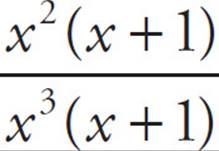 . Reduce the fraction to get
. Reduce the fraction to get  , or
, or  . Another way of writing
. Another way of writing  is x−1. Therefore, the correct answer is (D).
is x−1. Therefore, the correct answer is (D).
5. AStart with the easier equation first and use Process of Elimination. The easier equation has to do with the total number of solutions. According to the question, Régine measures a total of 100 solutions. This information can be expressed as x + y = 100. Eliminate (B) and (C) because neither of these answers includes this equation. Remember that percentage means divided by 100. Therefore, 40% = 0.4 and 70% = 0.7. Given this information, x should be associated with 0.4 and y should be associated with 0.7. On this basis eliminate (D). The correct answer is (A).
6. BThe graph shown is a regular parabola that has been turned upside down and moved down 6. The equation of a regular parabola that points upward is y = x2. Therefore, the graph of a parabola that points downwards is y = −x2. Eliminate (D) because that answer is missing the negative sign. To move a parabola down 6 units, a 6 must be subtracted from the equation of the parabola. Eliminate (A) and (C), which add 6 instead. Choice (B) can be rewritten as y = −x2 − 6. The correct answer is (B).
7. AUse Process of Elimination to solve this question. According to (A), the price of the item in 1999 was $10. According to the question, the price of the item in 2010 was $43, and the price of the item increased by $3 every year. 1999 is 11 years before 2010. Therefore, the price of the item in 1999 can be calculated as 43 − 11(3) = 10. Keep (A) but check the other answer choices just in case. Eliminate (B) and (C), since these answers could not also be correct. Eliminate (D) because the annual price increase is given as $3 in the question. Therefore, the correct answer is (A).
8. CUse the formula arc = rθ, where r is the radius and θ is the measure of the central angle in radians. Because the angle is already in radians, you just need to plug in 10 for the radius and the angle  into the formula. You then get s = (10)
into the formula. You then get s = (10) or 4π, which is (C).
or 4π, which is (C).
9. BStart by calculating the least amount of acetaminophen the child needs. If the child is 75 pounds, then the amount of acetaminophen needed can be calculated as  × 1,000 =
× 1,000 = ![]() × 1,000 = 500. Since, only (B) gives 500 as the low-end value, the correct answer is (B).
× 1,000 = 500. Since, only (B) gives 500 as the low-end value, the correct answer is (B).
10. CWhenever there are variables in the question and in the answer choices, think Plugging In, picking numbers that ensure that I is an integer. If P = 18 and R = 2, then I = 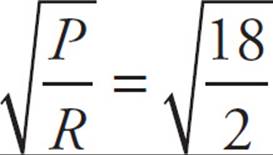 =
=  = 3. Because V = IR, V = 3 × 2 = 6. Plug P = 18, R = 2, and V = 6 into the answers to see which answer works. Choice (A) becomes 18 =
= 3. Because V = IR, V = 3 × 2 = 6. Plug P = 18, R = 2, and V = 6 into the answers to see which answer works. Choice (A) becomes 18 =  . Solve the right side of the equation to get 18 =
. Solve the right side of the equation to get 18 =  . This statement is not true, so eliminate (A). Choice (B) becomes 18 =
. This statement is not true, so eliminate (A). Choice (B) becomes 18 = ![]() . This statement is not true, so eliminate (B). Choice (C) becomes 18 =
. This statement is not true, so eliminate (B). Choice (C) becomes 18 =  . Solve the left side of the equation to get 18 =
. Solve the left side of the equation to get 18 =  . This statement is true, so keep (C), but check the remaining answer just in case. Choice (D) becomes 18 = (62)(23) or 18 = 36 × 8. This statement is not true, so eliminate (D). The correct answer is (C).
. This statement is true, so keep (C), but check the remaining answer just in case. Choice (D) becomes 18 = (62)(23) or 18 = 36 × 8. This statement is not true, so eliminate (D). The correct answer is (C).
11. DA root of the equation is the same as an x-intercept. In the graph, the function crosses the x-axis at 4 points. Therefore, the correct answer is (D).
12. ALabel the congruent angles, ∠ABC and ∠CDE, as such. In order to find the measure of those angles, use the formula 180(n − 2), where n is the number of sides, to determine the sum of the interior angles of the figure. Because the figure has five sides, plug 5 in for n to get 180(5 − 2), or 180(3), which equals 540. Subtract 120 to get 420. Subtract 100 to get 320. Subtract 40 to get 280. Since the two remaining angles are congruent, divide by 2 to find that the two unlabeled angles are both equal to 140. Because ∠ABC and ∠BCD have a combined measure of 180,  and
and ![]() are parallel. Therefore, (A) accurately describes the relationships in the figure.
are parallel. Therefore, (A) accurately describes the relationships in the figure.
13. BTaking the 4th root of a number is the same as taking the number to the ![]() power. Therefore, the equation can be rewritten as
power. Therefore, the equation can be rewritten as  . Divide both sides by 2 to get
. Divide both sides by 2 to get 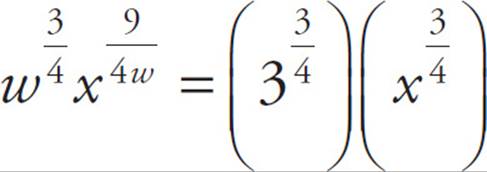 . Therefore, in the equation
. Therefore, in the equation  and
and  , so w = 3. The correct answer is (B).
, so w = 3. The correct answer is (B).
14. CWhenever there are variables in the question and in the answers, think Plugging In. If a = 2 and b = 3, r = [![]() (2) + 3]2 = (1 + 3)2 = 16, and s = −4(2)(3) + 3(3) = −24 + 9 = −15. The expression r − 2sbecomes 16 − 2(−15) = 16 + 30 = 46. Plug 2 in for a and 3 in for b in each of the answers to see which answer equals the target number of 46. Choice (A) becomes
(2) + 3]2 = (1 + 3)2 = 16, and s = −4(2)(3) + 3(3) = −24 + 9 = −15. The expression r − 2sbecomes 16 − 2(−15) = 16 + 30 = 46. Plug 2 in for a and 3 in for b in each of the answers to see which answer equals the target number of 46. Choice (A) becomes ![]() (22) + 32 − 7(2)(3) − 6(3) = 1 + 9 − 42 − 18 = −50. This does not match the target number, so eliminate (A). Choice (B) becomes
(22) + 32 − 7(2)(3) − 6(3) = 1 + 9 − 42 − 18 = −50. This does not match the target number, so eliminate (A). Choice (B) becomes ![]() (22) + 32 − 7(2)(3) + 6(3) = 1 + 9 − 42 + 18 = −14. Eliminate (B). Choice (C) becomes
(22) + 32 − 7(2)(3) + 6(3) = 1 + 9 − 42 + 18 = −14. Eliminate (B). Choice (C) becomes ![]() (22) + 32 + 9(2)(3) − 6(3) = 1 + 9 + 54 − 18 = 46. Keep (C), but check (D) just in case it also works. Choice (D) is the same as (C) except for the coefficient on the a2 term, so it can’t equal 46. Eliminate (D). The correct answer is (C).
(22) + 32 + 9(2)(3) − 6(3) = 1 + 9 + 54 − 18 = 46. Keep (C), but check (D) just in case it also works. Choice (D) is the same as (C) except for the coefficient on the a2 term, so it can’t equal 46. Eliminate (D). The correct answer is (C).
15. CFirst, start with a sketch of the two points to see what the line in question might look like.
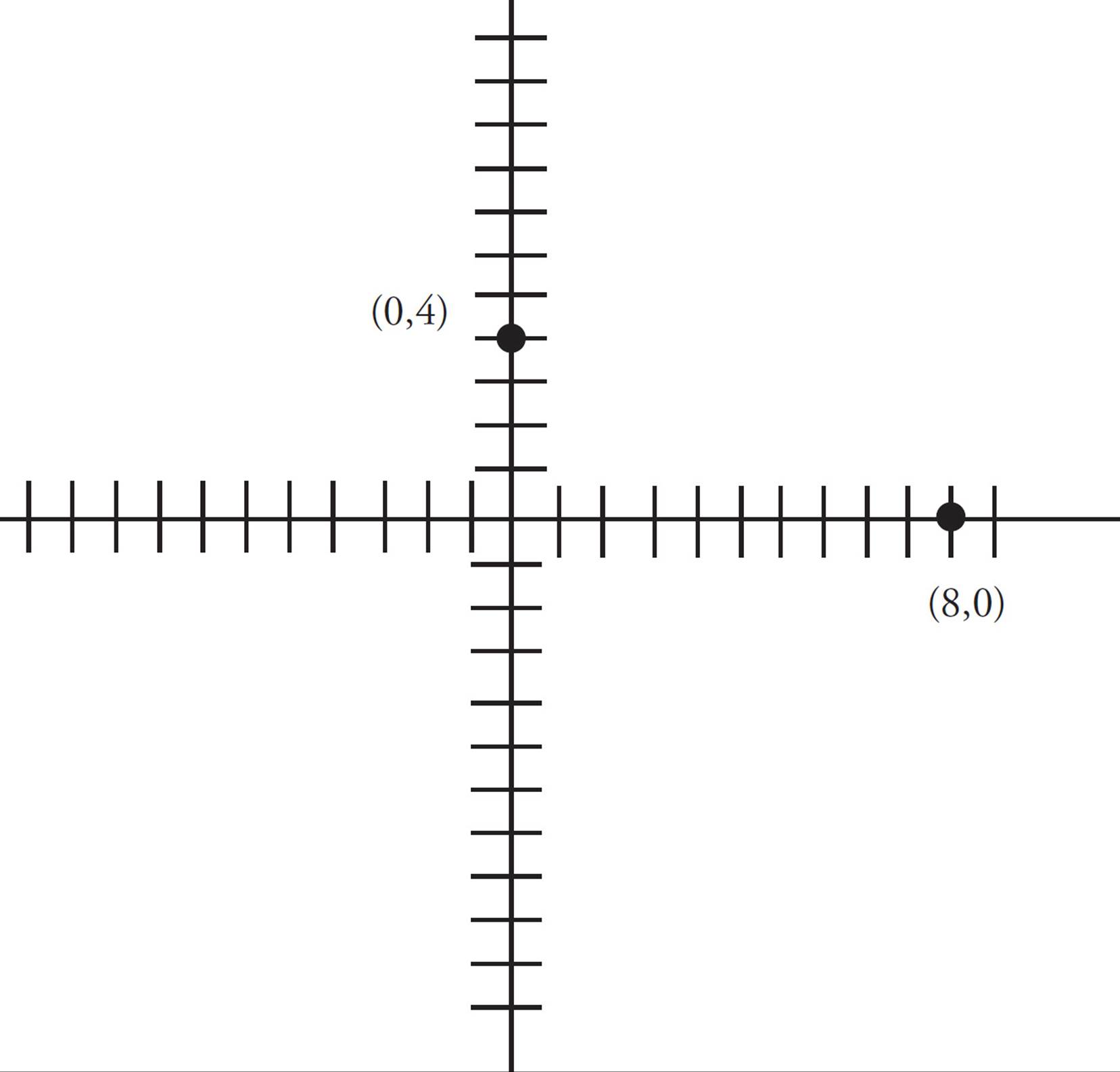
The point directly between the two points will definitely be on the line, so find the midpoint of the two points. Midpoint  = (4, 2). Check this point in the answer choices and eliminate any that do not contain it. Choice (A) becomes 2(2) = −4 + 8 or 4 = 4, which is true. Choice (B) becomes 2(2) = 4, and (C) becomes 2 = 2(4) − 6 or 2 = 8 − 6. These are also true, but (D) becomes 2 = −2(4), which is false. Eliminate (D). To sketch the remaining equations, rewrite them in slope-intercept form of the equation y = mx + b, where m is the slope and b is the y-intercept. Choice (A) becomes y = −
= (4, 2). Check this point in the answer choices and eliminate any that do not contain it. Choice (A) becomes 2(2) = −4 + 8 or 4 = 4, which is true. Choice (B) becomes 2(2) = 4, and (C) becomes 2 = 2(4) − 6 or 2 = 8 − 6. These are also true, but (D) becomes 2 = −2(4), which is false. Eliminate (D). To sketch the remaining equations, rewrite them in slope-intercept form of the equation y = mx + b, where m is the slope and b is the y-intercept. Choice (A) becomes y = −![]() x + 4, (B) becomes y =
x + 4, (B) becomes y = ![]() x, and (C) is already in the right form. Now sketch the graphs of each of these on the xy-plane.
x, and (C) is already in the right form. Now sketch the graphs of each of these on the xy-plane.
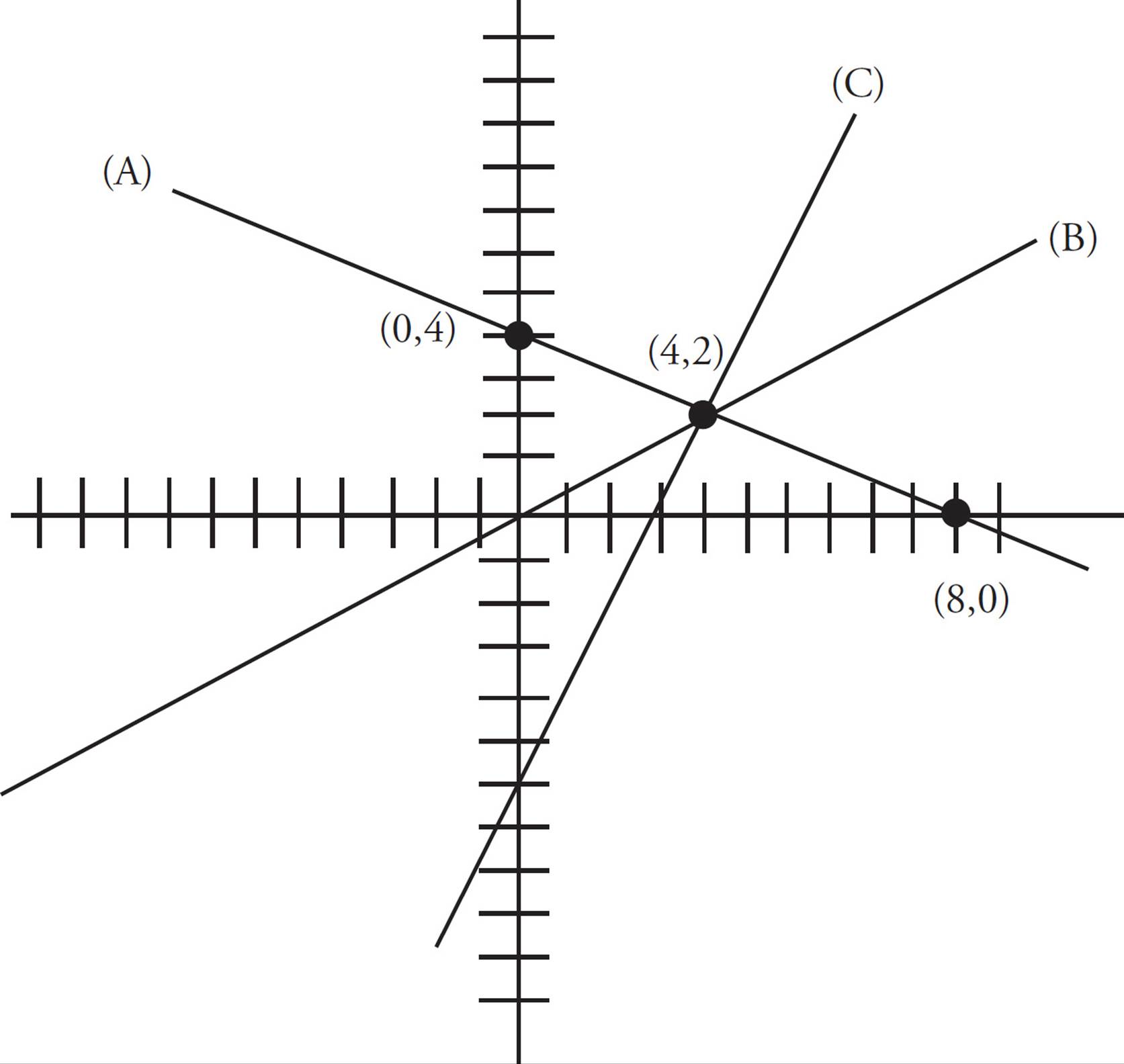
The line in (A) contains both the given points, but all the points to the left of (0, 4) are closer to that point and all those to the right of (8, 0) are closer to it. So eliminate (A). Many points on line (B) are also clearly closer to one or the other of the given points, so eliminate (B). Line (C) appears to be perpendicular to the line formed by the two given points, and this is in fact what will make all the points on a line equidistant from 2 given points. Therefore, the correct answer is (C).
16. ![]() or 2.33
or 2.33
Get rid of the fractions in the first equation by multiplying the entire equation by 6, to get 2p + 3q = 6. Whenever there are two equations with the same two variables, they can be solved simultaneously by adding or subtracting them. The key is to get one variable to disappear. Stack the equations and add them.
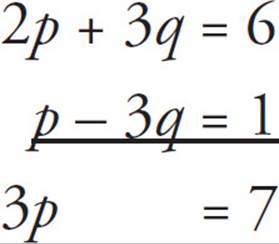
Therefore, p = ![]() .
.
17. 6Substitute x for y in the second equation to get (x − 2)2 − 4 = −x. Expand the left side of the equation to get (x − 2)(x − 2) − 4 = −x or x2 − 4x + 4 − 4 = −x. Simplify the equation to get x2 − 4x = −x. Set the equation to 0 to get x2 − 3x = 0. Factor an x out of the equation to get x(x − 3) = 0. Therefore, either x = 0 or x − 3 = 0, and x = 3. According to the question, the point of intersection is in quadrant I, where the x and y values are both positive. Therefore, x = 3 and y = 3. The sum of 3 + 3 = 6. The correct answer is 6.
18. 6Try Plugging In different values of c to see which ones work. Make a table to keep track of all the numbers.
|
c = |
(c − 1)2= |
|
1 |
(1 − 1)2 = 0 |
|
2 |
(2 − 1)2 = 1 |
|
3 |
(3 − 1)2 = 4 |
|
4 |
(4 − 1)2 = 9 |
|
5 |
(5 − 1)2 = 16 |
|
6 |
(6 − 1)2 = 25 |
|
7 |
(7 − 1)2 = 36 |
The largest value of c that works without hitting the boundaries of the inequality is 6, so the correct answer is 6.
19. 8When no picture is provided, it helps to draw one. First, rewrite each equation so that it is in the slope-intercept form of a line, which is y = mx + b, where m is the slope and b is the y-intercept of the line. The first equation becomes 2y ≤ x + 4, or y ≤ ![]() x + 2. The second equation becomes y ≥ 2x − 4. The resulting graph looks as follows:
x + 2. The second equation becomes y ≥ 2x − 4. The resulting graph looks as follows:
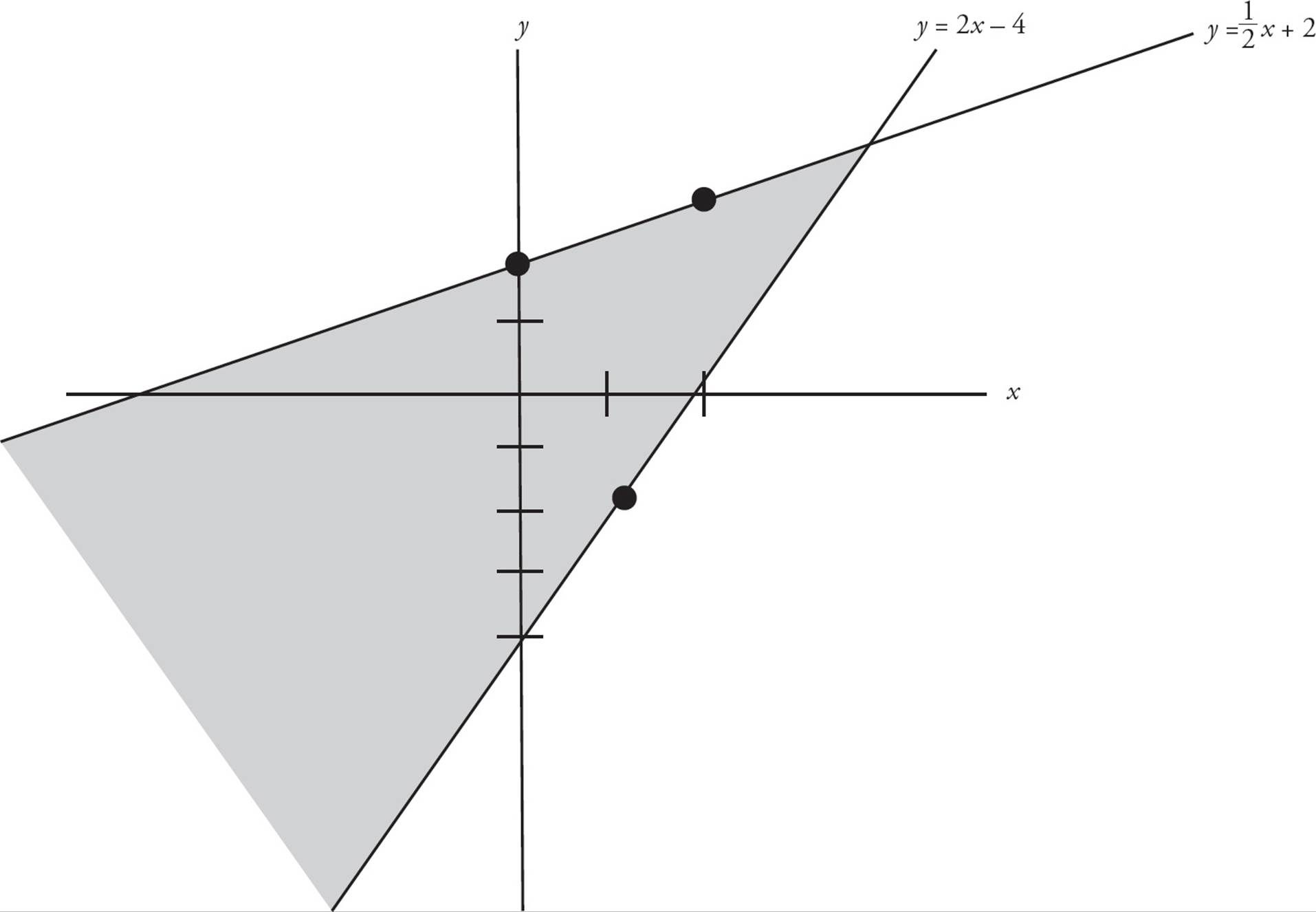
As the graph shows, the greatest x + y is the point at which the two lines intersect. Set the equations of the two lines, y = ![]() x + 2 and y = 2x − 4, equal to each other and solve for x. The resulting equation is
x + 2 and y = 2x − 4, equal to each other and solve for x. The resulting equation is ![]() x + 2 = 2x − 4. Solve for x to get −
x + 2 = 2x − 4. Solve for x to get −![]() x + 2 = −4 or −
x + 2 = −4 or −![]() x = −6, so x = 4. Next, plug 4 into one of the two equations to solve for y. Therefore, y = 2(4) − 4 = 4 and x + y = 4 + 4 = 8. The correct answer is 8.
x = −6, so x = 4. Next, plug 4 into one of the two equations to solve for y. Therefore, y = 2(4) − 4 = 4 and x + y = 4 + 4 = 8. The correct answer is 8.
20.  or 26.6 or 26.7
or 26.6 or 26.7
Start by drawing the figure and labeling what you know. Because you know ABCD and WXYZ are both squares, you know all the sides:
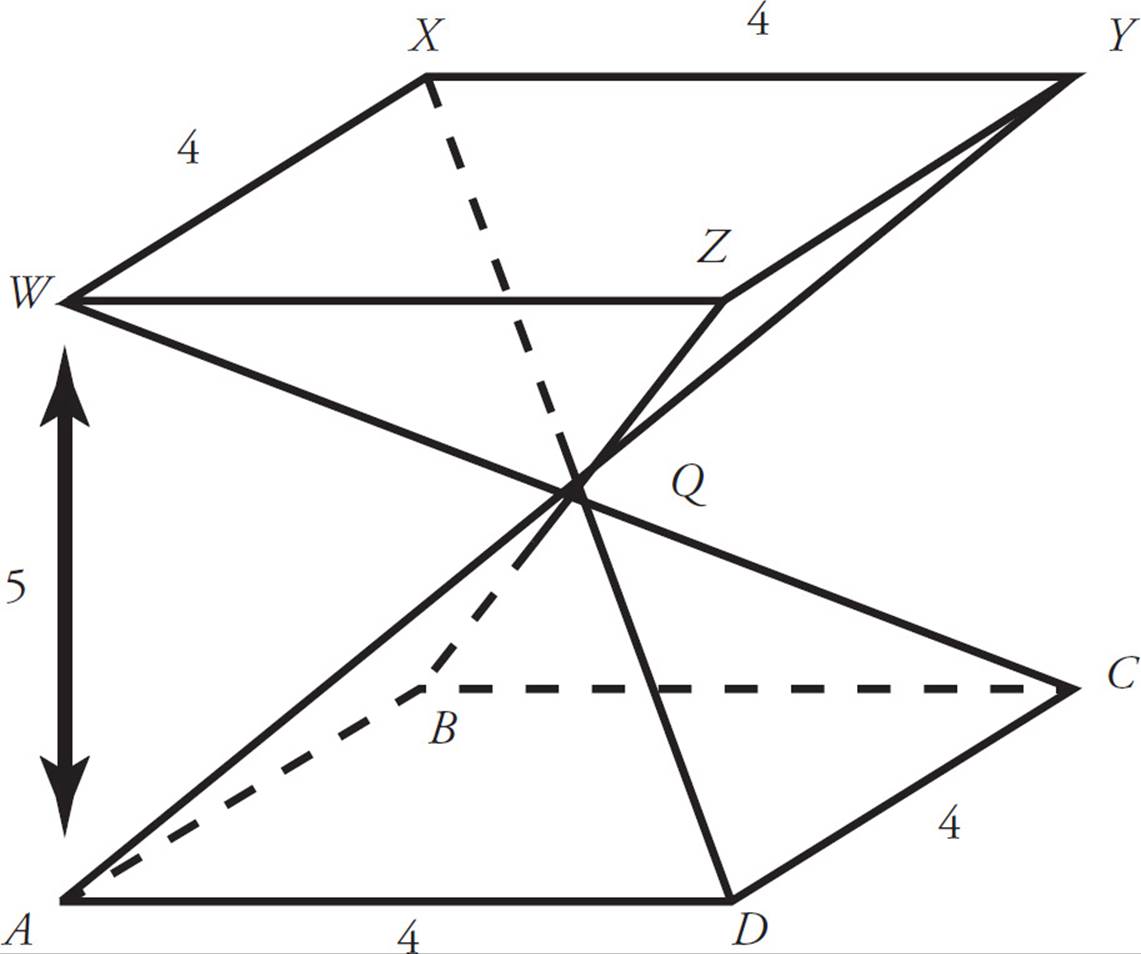
To find the areas of the two pyramids, you need the area of the bases and the heights. Because Q is equidistant from the points in each square and all the lines between the squares go through point Q, Q must itself be equidistant from the two planes. That makes Q 2.5 units from the middle of square ABCD and also 2.5 units from the middle of square WXYZ. This distance is the height of each pyramid.
Because the pyramids are equal, you can solve for the volume of one pyramid and double that for the answer.
Section 4: Math (Calculator)
1. DWhenever there are variables in the question and in the answers, think Plugging In. Let d = 2. For $1 the air pump dispenses 90 × 4 = 360 pounds of air. Therefore, for $2 the air pump will dispense 360 × 2 = 720 pounds of air. Plug in 2 for d in the answer choices to see which answer equals 720. Choice (A) becomes P = 2 + 90 = 92. Eliminate (A). Choice (B) becomes P = 2 + 360 = 362. Eliminate (B). Choice (C) becomes P = 90(2) = 180. Eliminate (C). Choice (D) becomes P = 360(2) = 720. Therefore, the correct answer is (D).
2. ASet up a proportion:  . Cross-multiply to get x = 6 × 0.30 = 1.8 meters. Therefore, the correct answer is (A).
. Cross-multiply to get x = 6 × 0.30 = 1.8 meters. Therefore, the correct answer is (A).
3. BIn order to find the undeveloped area, take the entire area of the park and subtract the area of the developed portions. Subtract the 4 acre lake to get 44 − 4 = 40 undeveloped acres. Next, subtract the largest and smallest possible soccer field area: 40 − 10 = 30, and 40 − 8 = 32. Therefore, the correct answer is (B).
4. BWeight is shown on the horizontal axis of the graph, given in tons. Look for the mark indicating 3 on this axis; then draw a vertical line from that mark to the line of best fit. Once you hit it, draw a horizontal line over to the vertical axis. It should hit between 20 and 25 miles per gallon, slightly closer to the mark for 25. This makes (B) the credited response. Draw your lines carefully, using your answer sheet as a straightedge if necessary, to avoid trap answers like the close-but-not-quite (C).
5. CYou can see from the graph that from 2000 to 2002, the number of coati increased from 140 to 160. From 2002 to 2004, the number increased from 160 to 180. Therefore, the number of coati is increasing at a rate of 20 every 2 years. In 2006, if the rate of increase remains the same, the number of coati should be 180 + 20 = 200, which is (C).
6. BThe question states that there are infinitely many solutions to the equation. That means any real number should work for d. Plug in an easy number like 0 for every d in the equation to get  . Simplify the equation to
. Simplify the equation to  =
= ![]() , so a = 10, which is (B).
, so a = 10, which is (B).
7. AFirst, convert the minutes shown in the graph to seconds. Multiply 15 minutes by 60 seconds to get 900 seconds. Then, since speed is distance divided by time, simply divide 3,000 meters by 900 seconds. The answer is 3.3 m/s, which is (A).
8. CPlug 2 in for y in the answers to see which function most closely equals the area of 14,910. Choice (A) becomes 15,000 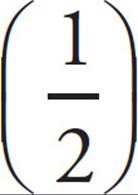 = 7,500. This does not match the target number, so eliminate (A). Choice (B) becomes 15,000(0.003)2 = 0.135. Eliminate (B). Choice (C) becomes 15,000(0.997)2 ≈ 14,910. The correct answer is (C).
= 7,500. This does not match the target number, so eliminate (A). Choice (B) becomes 15,000(0.003)2 = 0.135. Eliminate (B). Choice (C) becomes 15,000(0.997)2 ≈ 14,910. The correct answer is (C).
9. BFirst, calculate what Mike’s daily calorie consumption is during finals. 12% of 1,680 is 0.12 × 1,680 = 201.6. During finals Mike consumes 1,680 + 201.6 = 1,881.6 calories per day. Whenever the question includes variables, Plug in. Let d = 2. Over 2 days Mike consumes 2 × 1,881.6 = 3,763.2 calories. He also adds 900 calories at the end of finals. His total consumption over the entire finals period is 3,763.2 + 900 = 4,663.2 calories, so 4,663.2 is the target number. Plug in 2 for d in each of the answer choices. In (A), 1.12[1,680(2) + 900] = 4,771.2, which is not the target number. Eliminate (A). In (B), 1.12[1,680(2)] + 900 = 4,663.2, which is the target. Leave (B), but check the other answer choices just in case. In (C), 1.12(1,680 + 900)(2) = 5,779.2, and in (D), [1,680 + (0.12)(2)] + 900 = 2,580.24. Eliminate both (C) and (D). The correct answer is (B).
10. DUse Process of Elimination on this question. Choice (A) cannot be correct because more juniors prefer Austin to Pensacola. Choice (B) sounds appealing, but “more than three times as likely” means the seniors as a whole need to prefer Pensacola more than three times as much as the juniors do as a whole. Seniors prefer Pensacola 23 out of 42, or 55%. Juniors prefer it 7 out of 21, or 33%. So, seniors do not prefer Pensacola more than three times as much as juniors do. You can also eliminate (C) because more than half of all juniors prefer Austin, while less than half of all seniors prefer Austin. The statement in (D) is correct since 7 is one-third of the total of 21 juniors.
11. BWe are looking for the probability that a randomly selected person is a man with a doctoral degree. There are 16,232 men with doctoral degrees, and 220,532 total adults aged 25 years or older. So the probability that a randomly selected person fits the category we are looking for is 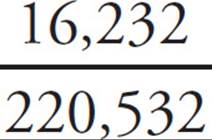 = 0.07 = 7%, which is (B).
= 0.07 = 7%, which is (B).
12. CWhenever there are variables in the question and in the answers, think Plugging In. If x = 10, then C = 110 +  = 110 + 5 = 115 and R = 15 (10) −
= 110 + 5 = 115 and R = 15 (10) −  = 150 −
= 150 −  = 150 − 10 = 140. Therefore, the profit can be calculated as 140 − 115 = 25. Plug 10 in for x in the answers to see which answer equals the target number of 25. Choice (A) becomes −
= 150 − 10 = 140. Therefore, the profit can be calculated as 140 − 115 = 25. Plug 10 in for x in the answers to see which answer equals the target number of 25. Choice (A) becomes −  −
−  (10) + 110 = −
(10) + 110 = −  − 31 (5) + 110 = −10 − 155 + 110 = −55. This doesn’t match the target number, so eliminate (A). Choice (B) becomes −
− 31 (5) + 110 = −10 − 155 + 110 = −55. This doesn’t match the target number, so eliminate (A). Choice (B) becomes − −
−  (10) + 110 = −
(10) + 110 = − − 29(5) + 110 = −10 − 145 + 110 = −45. Eliminate (B). Choice (C) becomes −
− 29(5) + 110 = −10 − 145 + 110 = −45. Eliminate (B). Choice (C) becomes − +
+  (10) − 110 = −
(10) − 110 = − + 29(5) − 110 = −10 + 145 − 110 = 25. Keep (C), but check (D) just in case it also works. Choice (D) becomes −
+ 29(5) − 110 = −10 + 145 − 110 = 25. Keep (C), but check (D) just in case it also works. Choice (D) becomes − +
+  (10) − 110 = −
(10) − 110 = − + 31(5) − 110 = −10 + 155 − 110 = 35. Eliminate (D) and choose (C).
+ 31(5) − 110 = −10 + 155 − 110 = 35. Eliminate (D) and choose (C).
13. DTo stay at his fancy hotel for three nights at 2,000 Moroccan dirhams per night, Erik will need 6,000 dirhams. Using the currency conversion rate of 1 dirham = $0.11, we can multiply 6,000 × 0.11 to determine that Erik’s hotel stay will cost $660. Since his bank allows him to withdraw only $200 at a time, Erik must go to the ATM four times: (D).
14. CStart with the easier equation first and use Process of Elimination. The easier equation involves the total amount of gas sold. According to the question, 850 gallons of gasoline were sold, which can be expressed as u + p = 850. Eliminate (D) since it does not include this equation. The other equation in the answers is related to the amount of money collected. According to the question, $3,016.50 was collected; however, this sum included a discount of $0.10 per gallon for 100 of the gallons that were purchased or $0.10 × 100 = $10. Without the discount unleaded gas costs $3.49 and premium gas costs $3.79 a gallon, and the amount of money collected would have been $3,016.50 + $10 = $3,026.50. Only (C) provides the correct total. Therefore, the correct answer is (C).
15. BFirst, let’s figure out how many students are enrolled in AP courses other than Biology and U.S. History. We know that 319 students are enrolled in at least one AP course, and of those, 75 + 58 = 133 are enrolled in Biology and U.S. History. However, since 22 students are enrolled in both of those courses, we need to subtract 22 from 133 (so as not to double-count the students taking both courses). That leaves us with 133 − 22 = 111 total students who are taking AP Biology and AP U.S. History. Of the 319 students taking AP courses, that means there are 319 − 111 = 208 students taking AP courses other than Biology and U.S. History. We know that there are 784 juniors and seniors total, so 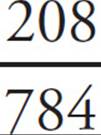 = 0.265, or approximately 27% of all juniors and seniors, which is (B).
= 0.265, or approximately 27% of all juniors and seniors, which is (B).
16. ATotal score = average score × the number of tests. In order for Mateo to receive a B, he needs his total score over the 3 tests to be between 3 × 80 = 240 points and 3 × 89 = 267 points. On his first and second tests, Mateo scored a total of 79 + 95 = 174 points. Therefore, on his third test Mateo must score between 240 − 174 = 66 and 267 − 174 = 93 points in order to receive a B. The correct answer is (A).
17. AUse Process of Elimination to solve this question. Choice (A) is possible so leave it. Choice (B) discusses the mass of the fertilizer, but no reference to mass is made in the question. Eliminate (B). According to the question, the quantity described in (C) is represented by A, so eliminate (C). According to the question, the quantity described in (D) is represented by Y, so eliminate (D). The correct answer is (A).
18. DThe mode of the combined groups cannot be determined without knowing exactly what scores each group received. To illustrate this, plug in! Let’s say that the scores of Group A were {1, 1, 7, 7, 7}, and the scores for Group B were {1, 1, 6, 6, 6}. The scores of the whole group would, therefore, be {1, 1, 1, 1, 6, 6, 6, 7, 7, 7}. This set has a mode of 1, so eliminate (A), (B), and (C) and choose (D).
19. CFirst, count the number of blocks that Josh needs to drive. He needs to drive 4 blocks north and 6 blocks east for a total of 10 blocks. You need to convert this into miles, which can be done with the following proportion:  . The drive is a total of 6 miles. Since Josh drives at 30 miles per hour, you can set up a second proportion:
. The drive is a total of 6 miles. Since Josh drives at 30 miles per hour, you can set up a second proportion:  . Cross-multiply and solve to get that x =
. Cross-multiply and solve to get that x =  or
or ![]() of an hour. This equals 12 minutes in (C).
of an hour. This equals 12 minutes in (C).
20. DThe first step is to rewrite the bottom equation so that it is in the same format as the first equation. Move all of the variables in the bottom equation to the left side of the equation to get 6s − t = 12. If the answer is (A) and there are infinitely many solutions to the system of equations, then the two equations must be the same equation. To determine whether this is the case, multiply the top equation through by 3 to get 6s − t = 30. Since it cannot be the case that the equation 6s − t equals both 12 and 30, the correct answer is (D). There are no solutions to the system of equations.
21. CTwo factors are important in determining how to poll a group: the size of the sample and how that sample is selected. Secretary Stephens’s plan has the largest sample with 250 students, but all those students belong to the senior class. Perhaps the senior class would prefer a theme that the other three classes would not. The sample is skewed and not necessarily representative of the entire student body, so eliminate (B). The other three plans all poll 100 students, so the manner in which those students are selected becomes more important. President Peterson’s plan is also skewed specifically to friends of the student council members, whose opinions might not reflect the majority, so eliminate (A). Vice President Vaiyda’s plan has more potential for a varied sample, but it is still not as good as Treasurer Thompson’s plan, which guarantees that a random assortment of people will be chosen for the poll. Eliminate (D), and choose (C).
22. CSince x and y are points on the circle, plug in the point (−2, −2) into the left side of the equation. This gives you (−2 + 3)2 + (−2 − 1)2, which equals 12 + (−3)2. Simplifying, you get 10. Because 10 is greater than r2 (which is 9), the point must be outside the circle, which is (C).
23. DWhenever the question includes variables, think Plugging In. According to the question, 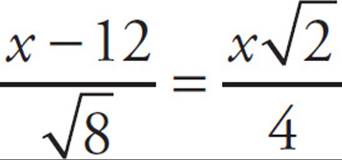 − C. Plug in 12 for x to get
− C. Plug in 12 for x to get 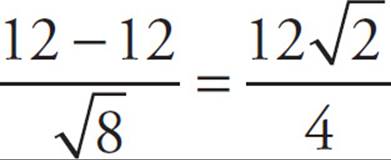 − C, or
− C, or 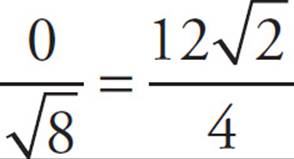 − C. Solve for C to get
− C. Solve for C to get 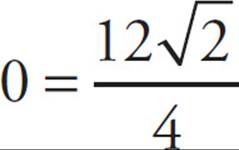 − C, then 0 = 3
− C, then 0 = 3 − C, and finally 3
− C, and finally 3 = C. The correct answer is (D).
= C. The correct answer is (D).
24. AAll of the answer choices refer to the number of salary-satisfied bachelor’s-degree-holders, so you must use the follow-up survey results to calculate that number. First, find the percent of bachelor’s-degree-holders who reported also being salary-satisfied in the follow-up survey. This number was 658 out of the 1,000 people, so divide 658 by 1,000 and then multiply by 100 to get the percent. The result is 65.8% salary-satisfied bachelor’s-degree-holders for the follow-up survey. Since the people in the follow-up were randomly selected, you can assume that they are generally representative of the bachelor’s-degree-holding population at large. Therefore, the 65.8% of salary-satisfied individuals should be true of all 24,236,000 job-satisfied bachelor’s-degree-holders. Watch the units on charts—this one is in the thousands, so there are 24,236,000 not 24,236 job-satisfied bachelor’s-degree-holders. Multiply 65.8%, or .658, by the total number of bachelor’s-degree-holders, 24,236,000, to find that there should be 15,947,288 salary-satisfied, job-satisfied bachelor’s-degree-holders. Choice (A) is the closest to this and is the credited response.
25. AThe equation of a line expressed in slope-intercept form is y = mx + b, where m is the slope and b is the y-intercept. One way to find the y-intercept of line d is to plug in the slope and given point and slope for b. The equation y = mx + b becomes 1 = ![]() (1) + b. Subtract
(1) + b. Subtract ![]() from both sides to get b =
from both sides to get b = ![]() . Another approach is to use the slope formula to find b. The y-intercept of a line is where the line crosses the y-axis; at that point x = 0. Therefore, in addition to the point (1, 1), there is another point (0, b) that lies on line d. The equation for finding the slope of the line given two points is
. Another approach is to use the slope formula to find b. The y-intercept of a line is where the line crosses the y-axis; at that point x = 0. Therefore, in addition to the point (1, 1), there is another point (0, b) that lies on line d. The equation for finding the slope of the line given two points is 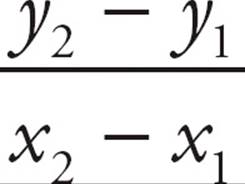 . Therefore
. Therefore 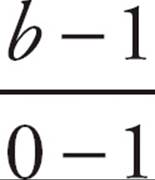 =
= ![]() or
or 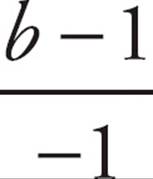 =
= ![]() . Cross-multiply to get 5(b − 1) = −4. Distribute the 5 to get 5b − 5 = −4. Solve for b to get 5b = 1, and b =
. Cross-multiply to get 5(b − 1) = −4. Distribute the 5 to get 5b − 5 = −4. Solve for b to get 5b = 1, and b = ![]() . The y-intercept of line e is 3 times
. The y-intercept of line e is 3 times ![]() , so the y-intercept of line e is
, so the y-intercept of line e is ![]() . Additionally, parallel lines have slopes that are equal to each other. Therefore, line e will also have a slope equal to
. Additionally, parallel lines have slopes that are equal to each other. Therefore, line e will also have a slope equal to ![]() . Rewrite the equation in (A) in the slope-intercept form of the equation to get 5y = 4x +3, or y =
. Rewrite the equation in (A) in the slope-intercept form of the equation to get 5y = 4x +3, or y = ![]() x +
x + ![]() . The slope of this line is
. The slope of this line is ![]() and the y intercept is
and the y intercept is ![]() . Therefore, the correct answer is (A).
. Therefore, the correct answer is (A).
26. BAn extraneous solution is an answer that when plugged back into the equation causes the equation to be false. Begin by factoring and reducing the fraction on the left side of the equation to get 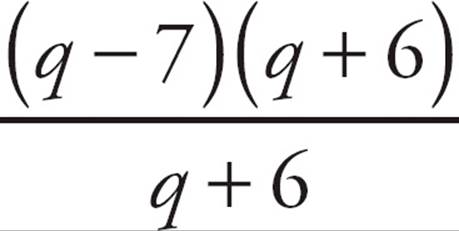 =
= 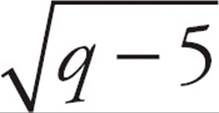 or q − 7 =
or q − 7 = 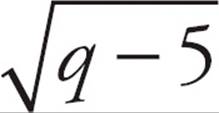 . Square both sides of the equation to get q2 − 14q + 49 = q − 5. Set the equation to 0 to get q2 − 15q + 54 = 0. Factor the quadratic to get (q − 9)(q − 6) = 0. Therefore, q = 9 or q = 6. Eliminate (A) and (C) because neither of these answers is a possible solution for q. Plug 6 in for q in the equation to see if this value of q works. The equation becomes
. Square both sides of the equation to get q2 − 14q + 49 = q − 5. Set the equation to 0 to get q2 − 15q + 54 = 0. Factor the quadratic to get (q − 9)(q − 6) = 0. Therefore, q = 9 or q = 6. Eliminate (A) and (C) because neither of these answers is a possible solution for q. Plug 6 in for q in the equation to see if this value of q works. The equation becomes  . Solve both sides of the equation to get
. Solve both sides of the equation to get 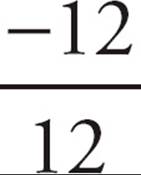 = 1. Since this statement is not true, 6 is the extraneous solution. The correct answer is (B).
= 1. Since this statement is not true, 6 is the extraneous solution. The correct answer is (B).
27. DFirst, determine the total number of gamers in each game type by adding up the columns. There are 110,000,000 gamers preferring first person shooters, 52,000,000 preferring sports games, and 85,000,000 preferring adventure games. You don’t know by how much the 9- to 13-year old group will increase in sport game preference, but presumably the increase will be made to match the currently largest group, first person shooters. Therefore, in order to raise adventure games to the level of first person shooters, you need to add 110,000,000 − 85,000,000 = 25,000,000 gamers to the adventure games group. If you are going to do so by doubling one of the age groups, then 25,000,000 is equal to the size of the current group. 9- to 13-year olds currently have 25,000,000 preferring adventure games, so (D) is your answer.
28. AWhenever there are variables in the question and in the answers, think Plugging In. Let’s say that for Emilio a = 2, t = 4, and k = 10. Then Emilio’s accrued vacation days can be calculated as V(t) = 2(4) + 10 = 18. This means that Martin has accrued 18 + 9 = 27 vacation days. Because a and k are constants, their values do not change. The number of years that Martin has worked at the manufacturing plant can therefore be calculated as 27 = 2t + 10. Solve for t to get 17 = 2t or t =  = 8.5. Therefore, Martin has worked 8.5 − 4 = 4.5 more years than Emilio. Plug 2 in for a in the answers to see which answer equals 4.5. Choice (A) becomes
= 8.5. Therefore, Martin has worked 8.5 − 4 = 4.5 more years than Emilio. Plug 2 in for a in the answers to see which answer equals 4.5. Choice (A) becomes ![]() = 4.5. Keep (A) but check the remaining answers just in case. Choice (B) becomes 9 − 2 = 7, (C) becomes 9 + 2 = 11, and (D) becomes 9(2) = 19. Eliminate (B), (C), and (D). The correct answer is (A).
= 4.5. Keep (A) but check the remaining answers just in case. Choice (B) becomes 9 − 2 = 7, (C) becomes 9 + 2 = 11, and (D) becomes 9(2) = 19. Eliminate (B), (C), and (D). The correct answer is (A).
29. CSOHCAHTOA tells you that sine is 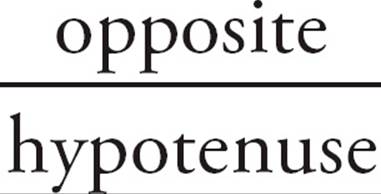 , so if the side opposite the angle with measure x° is O and the hypotenuse is H, then
, so if the side opposite the angle with measure x° is O and the hypotenuse is H, then 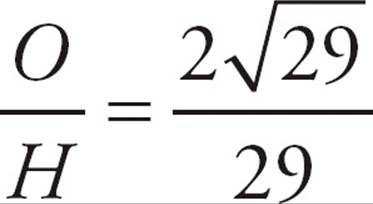 . Solve for O, and you get
. Solve for O, and you get 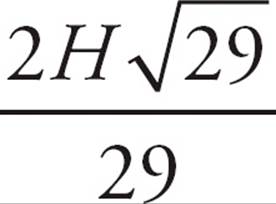 . Now, you can use the Pythagorean theorem with the given side and substituting
. Now, you can use the Pythagorean theorem with the given side and substituting 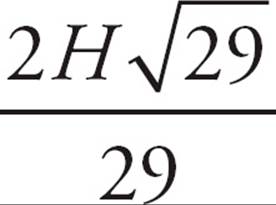 for O in order to solve for H: 102 +
for O in order to solve for H: 102 + 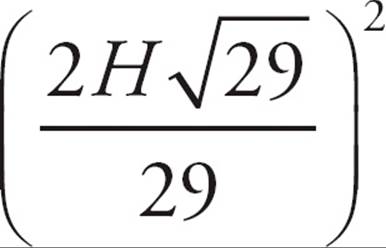 = H2. Solve the exponents, and then reduce the fraction: 100 +
= H2. Solve the exponents, and then reduce the fraction: 100 + 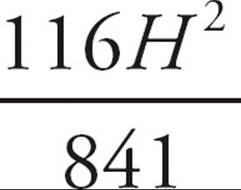 = H2; 100 +
= H2; 100 + 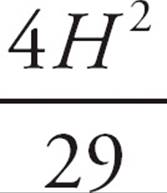 = H2. Subtract
= H2. Subtract 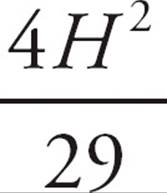 from both sides: 100 =
from both sides: 100 = 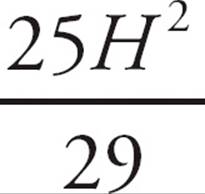 . Divide both sides by
. Divide both sides by  , so 116 = H2. Square root both sides, and you find that H = 2
, so 116 = H2. Square root both sides, and you find that H = 2 . Using
. Using 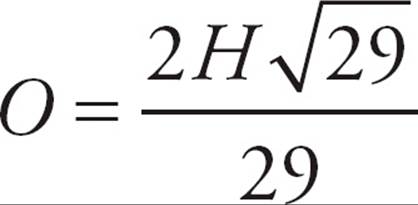 from above, you can solve for O:
from above, you can solve for O: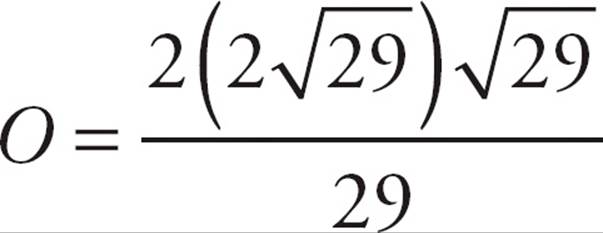 = 4. Add the sides and you get 14 + 2
= 4. Add the sides and you get 14 + 2 , which is (C).
, which is (C).
30. DA good approach to this question would be to plug in some numbers. Start with the number of juniors and plug in a number that is easy to deal with, such as 200. Then you can set up a proportion using the ratio given in the question stem:  . Cross-multiply and solve for x to determine that the number of seniors would be 150. Next, use the relationship
. Cross-multiply and solve for x to determine that the number of seniors would be 150. Next, use the relationship 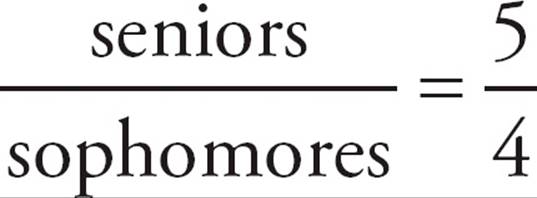 . Using 150 for seniors, you get
. Using 150 for seniors, you get  . Cross-multiply and solve for x to determine that the number of sophomores would be 120. Next, use the relationship
. Cross-multiply and solve for x to determine that the number of sophomores would be 120. Next, use the relationship 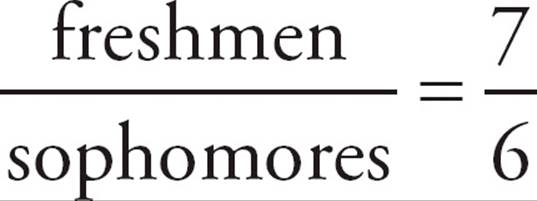 . Using 120 for sophomores, you get
. Using 120 for sophomores, you get  . Cross-multiply and solve for x to determine that the number of freshmen would be 140. The ratio of freshmen to seniors, therefore, would be
. Cross-multiply and solve for x to determine that the number of freshmen would be 140. The ratio of freshmen to seniors, therefore, would be  , which is (D).
, which is (D).
31. 75Hayoung swims 2.5 miles. She runs 11 × 2.5 = 27.5 miles, and she bikes 18 × 2.5 = 45 miles. Her total triathlon mileage = 2.5 + 27.5 + 45 = 75 miles. The correct answer is 75.
32. 5Plug 1,230 in for the value of the function to get 1,230 = 250x − 20. Solve for x to get 1,250 = 250x and x = 5. The correct answer is 5.
33. 918In order to find the greatest profit, maximize the number of acres of soybeans Marty plants, since soybeans bring in more money per acre than does wheat. At most, Marty can plant 7 acres of soybeans. Therefore, the most money he can make on soybeans is 7 × 120 = 840. He then has 9 − 7 = 2 acres left on which to plant wheat. The money he makes from this wheat is 2 × 90 = 180. The total amount Marty makes before taxes is therefore 840 + 180 = 1,020. The tax on this money equals 1,020 × 0.10 = 102. Subtract the amount Marty pays in taxes to get 1,020 − 102 = 918 profit. The correct answer is 918.
34. 19The formula for the area of a circle is A = πr2. If a full circle were shown, its radius would be 4, so the area of the full circle would be A = π42 = 16π. The interior angle of the fraction of the circle shown can be calculated as 90 + 45 = 135 degrees. Therefore, the figure shown is 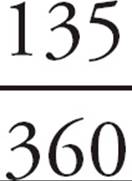 of the area of a full circle. The area of the figure can be calculated as
of the area of a full circle. The area of the figure can be calculated as  (16π) = 0.375(16π) = 6π ≈ 18.8 ≈ 19. The correct answer is 19.
(16π) = 0.375(16π) = 6π ≈ 18.8 ≈ 19. The correct answer is 19.
35. 6The two triangles share three angles; thus they are similar.  is twice the length of
is twice the length of ![]() because it is bisected by
because it is bisected by  . This relationship is constant between the two similar triangles. Therefore,
. This relationship is constant between the two similar triangles. Therefore,  is half of
is half of  : 12 ÷ 2 = 6.
: 12 ÷ 2 = 6.
36. 20First, determine the grams of protein in the bar. If the bar contains 32% of the daily recommended serving of protein, and the daily recommended serving of protein is 50 grams, then the bar contains 0.32 × 50 = 16 grams of protein. Next, determine the grams of fat in the bar by using the percent change equation: percent change = 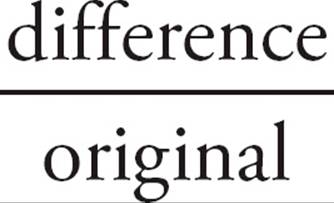 × 100. The percent change is 700, and the original is the grams of fat (because percent more means the original is the smaller number), which means 700 =
× 100. The percent change is 700, and the original is the grams of fat (because percent more means the original is the smaller number), which means 700 = 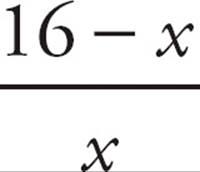 × 100. Divide both sides by 100: 7 =
× 100. Divide both sides by 100: 7 =  . Multiply both sides by x to get 7x = 16 − x. Add x to both sides to get 8x = 16. Divide both sides by 8 and you find x = 2. That is the number of grams of fat in the bar. To find the daily recommended serving of fat, translate English to math. 2 is 10% of the daily recommended serving, so if the daily recommended serving is y, 2 = 0.10y. Divide both sides by 0.10, and you find that the daily recommended serving of fat is 20.
. Multiply both sides by x to get 7x = 16 − x. Add x to both sides to get 8x = 16. Divide both sides by 8 and you find x = 2. That is the number of grams of fat in the bar. To find the daily recommended serving of fat, translate English to math. 2 is 10% of the daily recommended serving, so if the daily recommended serving is y, 2 = 0.10y. Divide both sides by 0.10, and you find that the daily recommended serving of fat is 20.
37. 1First, you need to determine the content of Set R. If Set R consists of all the one-digit prime numbers, then R = {2, 3, 5, 7}. The sum of the elements of Set S would therefore be 2 + 3 + 5 + 7 + x = 30. Combine like terms: 17 + x = 30. Subtract 17 from both sides, and you find x = 13. Plug x = 13 into the equation and solve: (13)2 − 11(13) − 25 = 1.
38. 8The additional positive integer x cannot equal 2, 3, 5, or 7 (otherwise there would be a mode). Next, determine what the median could be for various ranges of x. If x is less than 2, then the set would be, in consecutive order, {x, 2, 3, 5, 7}, making the median 3. Try this set. If the median equals the mean, then the sum of the elements divided by 5 (the number of elements) must equal 3:  = 3. Multiply both sides by 5 and combine like terms: x + 17 = 15. Subtract 17 from both sides, and you find x = −2. However, x must be a positive integer, so this doesn’t work. Try a new median. If x = 4, then the set is {2, 3, 4 (x), 5, 7), with a median of 4. However, the mean is
= 3. Multiply both sides by 5 and combine like terms: x + 17 = 15. Subtract 17 from both sides, and you find x = −2. However, x must be a positive integer, so this doesn’t work. Try a new median. If x = 4, then the set is {2, 3, 4 (x), 5, 7), with a median of 4. However, the mean is  = 5.25, not 4, so this doesn’t work. If x is 6 or greater, the set would either be {2, 3, 5, 6 (x), 7} or {2, 3, 5, 7, x}. In either case, the median is 5. Set up the average equal to the median of 5:
= 5.25, not 4, so this doesn’t work. If x is 6 or greater, the set would either be {2, 3, 5, 6 (x), 7} or {2, 3, 5, 7, x}. In either case, the median is 5. Set up the average equal to the median of 5:  = 5. Multiply both sides by 5 and combine like terms: 17 + x = 25. Subtract 17 from both sides, and you find that x = 8.
= 5. Multiply both sides by 5 and combine like terms: 17 + x = 25. Subtract 17 from both sides, and you find that x = 8.